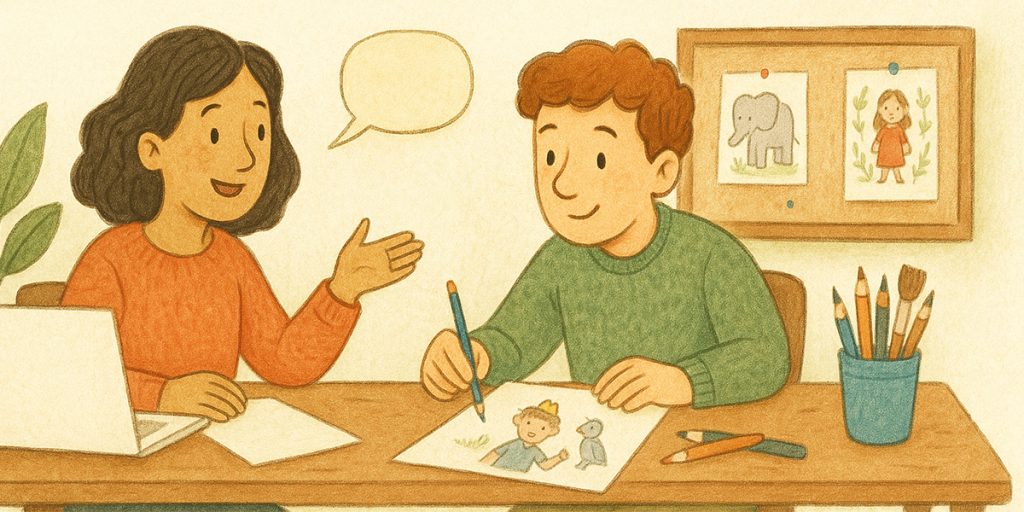Creating a children’s book that delights young readers isn’t just about beautiful artwork or a charming story. The true magic lies in how the words and illustrations work together on the page. A well-structured picture book layout design keeps children engaged, builds anticipation, and makes them eager to flip to the next page. Mastering page turns is an art—and it’s one of the most powerful storytelling tools available to authors and illustrators.
In this guide, we’ll explore eight layout secrets that elevate the reading experience, using effective page turn techniques in children’s books and proven layout tips for picture books.
1. Use Visual Rhythm to Control Pacing
Children’s books thrive on rhythm—not only in the words but also in the visuals. Pacing in children’s book illustration is influenced by how much action or detail you place on a page. A busy spread with bold artwork can quicken the tempo, while a simple, quiet page slows the reader down. By alternating between energetic and calm layouts, you create a natural rhythm that sets up powerful page turns.
Also Read:9 Stages of Picture Book Illustration
2. Create Anticipation with Cliffhangers
A strong page turn technique is leaving something unresolved on one page so that curiosity drives the reader forward. It can be a half-revealed illustration, a sentence ending with ellipses, or a visual that suggests something is just about to happen. This strategy mirrors cinematic suspense, making children lean in with excitement to discover what’s next.
3. Balance Text and Illustration
In effective picture book layout design, text placement is just as important as the illustration. Too much text can overwhelm young readers, while too little might not support the artwork. Place text strategically—sometimes integrating it within the artwork, sometimes giving it breathing room. This balance helps guide the eye naturally and keeps the reader flowing toward the page turn.
4. Vary Page Sizes and Perspectives
A subtle yet powerful layout tip for picture books is to shift perspectives. Close-up illustrations create intimacy and tension, while wide, open spreads give a sense of release or resolution. By varying the visual scale, you add surprise and drama that makes each page turn feel like a reveal.
5. Align Illustration Flow with the Narrative
Children read not only words but also pictures. In a strong children’s book illustration layout, characters often look or move toward the edge of the page—directing the child’s eye to turn over. For example, a character peeking beyond the page boundary creates curiosity. This flow of illustration works like an arrow pointing toward the next scene.
Also Read:11 Common Picture-Book Art Mistakes
6. Use White Space as a Storytelling Tool
White space is not empty space—it’s breathing room. By incorporating blank areas around text or illustration, you give children’s eyes a rest and emphasize key moments. When used just before a critical page turn, white space creates dramatic pause, enhancing the surprise or emotional punch on the next spread.
7. Build Consistency but Add Surprise
While consistency in style reassures young readers, carefully placed surprises keep them engaged. Perhaps every spread has a similar text block placement, until one page breaks the pattern with full-bleed art. This unexpected shift in illustration layout cues the reader that something important is happening, making the page turn even more powerful.
8. End Each Spread with Forward Momentum
A spread should never feel like a complete ending (unless it’s the last page). Instead, design each spread so it naturally flows into the next. This can be achieved with unfinished sentences, characters in mid-action, or illustrations that continue across the gutter. Effective page turn techniques in children’s books make each spread feel like part of a larger, unstoppable journey.
Also Read:10 Pro Tips for Smooth Author Illustrator Collaboration
Why Page Turns Matter
For young readers, turning the page is part of the adventure. Strong picture book layout design transforms the book into an interactive experience. Each flip becomes a reward: a chance to uncover a surprise, laugh at a joke, or feel a surge of emotion. By carefully planning pacing, rhythm, and illustration flow, authors and illustrators ensure their stories stay memorable long after the book is closed.
Quick Checklist for Picture Book Layout
Here’s a simple checklist of layout tips for picture books to keep in mind:
- Alternate busy and quiet spreads to control pacing.
- Use cliffhangers or unfinished sentences for suspense.
- Balance text and illustration placement.
- Direct characters’ gaze or movement toward the page edge.
- Apply white space before dramatic turns.
- Maintain consistency with room for surprise.
- Ensure each spread ends with forward momentum.
Conclusion
Designing a children’s book is more than arranging words and pictures—it’s about crafting an emotional journey. Thoughtful pacing in children’s book illustration, combined with creative page-turn techniques, transforms a simple story into an unforgettable reading experience. By applying these eight layout secrets, you’ll not only strengthen your storytelling but also keep children eagerly turning the pages.
At The Rainbow Stories, we help authors and illustrators bring their creative vision to life through professional picture book design and illustration services. If you’re working on your own children’s story, mastering picture book layout design could be the key to making your words and illustrations shine together in the most magical way possible.







